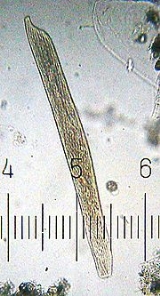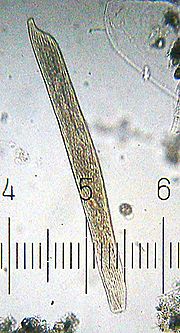
Spirostomum
Encyclopedia
Spirostomum is a genus of free-living ciliate
protist
s, belonging to the class Heterotrichea. Species of Spirostomum are found in both salt and fresh water. All are elongated, flexible and highly contractile. Although unicellular, members of some species can grow as long as 4 mm (0.15748031496063 in).
 The body of the cell is long and worm-like. In cross section it is mainly cylindrical, but may be flattened at the tail end. The posterior excretory vacuole
The body of the cell is long and worm-like. In cross section it is mainly cylindrical, but may be flattened at the tail end. The posterior excretory vacuole
is large, and may fill the whole "tail." Cilia on the cell body are short and arranged in longitudinal rows. The length of the peristome
varies between species, from about 1/4 to as much as two 2/3 the length of the cell. The peristome is fringed with membranelle
s, which are used to channel particles of food into the creature's oral cavity. The macronucleus
may be moniliform (like a string of beads) or compact and oval, depending on the species.
Spirostomum reproduces by binary fission. Reproduction may be purely asexual, or it may follow conjugation
, during which compatible mating individuals come together and transfer genetic material across a cytoplasmic link.
Members of the genus are extremely contractile. When startled, Spirostomum ambiguum can contract to less than half its extended length within 1/200 of a second (a contraction speed similar to that of the ciliate Vorticella
). As it contracts, the cortex of the cell twists and widens, and its spiral structure becomes visible. The mechanism of Spirostomum's contractility was first studied by Ernst Haeckel
in 1873 and has continued to attract scholarly attention.
Certain species have proven to be sensitive to the presence of heavy metals, and have been used by ecologists as indicators of water purity.
One widely distributed but rarely seen species, Spirostomum semivirescens, carries symbiotic zoochlorellae and houses itself within a mucilaginous lorica
.
in 1833, and placed in the family Spirostomidae by Samuel Friedrich von Stein
in 1867.
Recent analyses of ribosomal RNA gene sequences have confirmed that it is a monophyletic group.
Ciliate
The ciliates are a group of protozoans characterized by the presence of hair-like organelles called cilia, which are identical in structure to flagella but typically shorter and present in much larger numbers with a different undulating pattern than flagella...
protist
Protist
Protists are a diverse group of eukaryotic microorganisms. Historically, protists were treated as the kingdom Protista, which includes mostly unicellular organisms that do not fit into the other kingdoms, but this group is contested in modern taxonomy...
s, belonging to the class Heterotrichea. Species of Spirostomum are found in both salt and fresh water. All are elongated, flexible and highly contractile. Although unicellular, members of some species can grow as long as 4 mm (0.15748031496063 in).
Appearance and characteristics

Vacuole
A vacuole is a membrane-bound organelle which is present in all plant and fungal cells and some protist, animal and bacterial cells. Vacuoles are essentially enclosed compartments which are filled with water containing inorganic and organic molecules including enzymes in solution, though in certain...
is large, and may fill the whole "tail." Cilia on the cell body are short and arranged in longitudinal rows. The length of the peristome
Peristome
The word peristome is derived from the Greek peri, meaning 'around' or 'about', and stoma, 'mouth'. It is a term used to describe various anatomical features that surround an opening to an organ or structure. The term is used in plants and invertebrate animals, such as in describing the shells of...
varies between species, from about 1/4 to as much as two 2/3 the length of the cell. The peristome is fringed with membranelle
Membranelle
Membranelles are structures found around the mouth, or cytostome, in ciliate protists. They are typically arranged in series, to form an "adoral zone of membranelles," or AZM, on the left side of the buccal cavity . The membranelles are made up of kinetosomes arranged in groups to make up...
s, which are used to channel particles of food into the creature's oral cavity. The macronucleus
Macronucleus
A macronucleus is the larger type of nucleus in ciliates. Macronuclei are polyploid and undergo direct division without mitosis. It controls the non-reproductive cell functions, the everyday tasks, such as metabolism...
may be moniliform (like a string of beads) or compact and oval, depending on the species.
Spirostomum reproduces by binary fission. Reproduction may be purely asexual, or it may follow conjugation
Isogamy
Isogamy is a form of sexual reproduction that involves gametes of similar morphology , differing only in allele expression in one or more mating-type regions...
, during which compatible mating individuals come together and transfer genetic material across a cytoplasmic link.
Members of the genus are extremely contractile. When startled, Spirostomum ambiguum can contract to less than half its extended length within 1/200 of a second (a contraction speed similar to that of the ciliate Vorticella
Vorticella
Vorticella is a genus of protozoa, with over 16 known species. They are stalked inverted bell-shaped ciliates, placed among the peritrichs. Each cell has a separate stalk anchored onto the substrate, which contains a contractile fibril called a myoneme. When stimulated this shortens, causing the...
). As it contracts, the cortex of the cell twists and widens, and its spiral structure becomes visible. The mechanism of Spirostomum's contractility was first studied by Ernst Haeckel
Ernst Haeckel
The "European War" became known as "The Great War", and it was not until 1920, in the book "The First World War 1914-1918" by Charles à Court Repington, that the term "First World War" was used as the official name for the conflict.-Research:...
in 1873 and has continued to attract scholarly attention.
Certain species have proven to be sensitive to the presence of heavy metals, and have been used by ecologists as indicators of water purity.
One widely distributed but rarely seen species, Spirostomum semivirescens, carries symbiotic zoochlorellae and houses itself within a mucilaginous lorica
Lorica
Lorica is a Latin word literally meaning body armour and may refer to:* A number of types of Roman armour:**Lorica hamata, a hauberk of mail**Lorica manica, armguard**Lorica musculata, a folk term for a muscle cuirass...
.
Classification
The genus Spirostomum was established by Christian Gottfried EhrenbergChristian Gottfried Ehrenberg
Christian Gottfried Ehrenberg , German naturalist, zoologist, comparative anatomist, geologist, and microscopist, was one of the most famous and productive scientists of his time.- Early collections :...
in 1833, and placed in the family Spirostomidae by Samuel Friedrich von Stein
Samuel Friedrich Stein
Samuel Friedrich Nathaniel Ritter von Stein was a German entomologist chiefly interested in Diptera.Born in Niemegk near Potsdam, Brandenburg, in 1850, Stein became a Professor at the Forest and Agriculture Institute in Tharandt in Sachsen , 20 km south-west of Dresden. This was one of the...
in 1867.
Recent analyses of ribosomal RNA gene sequences have confirmed that it is a monophyletic group.

